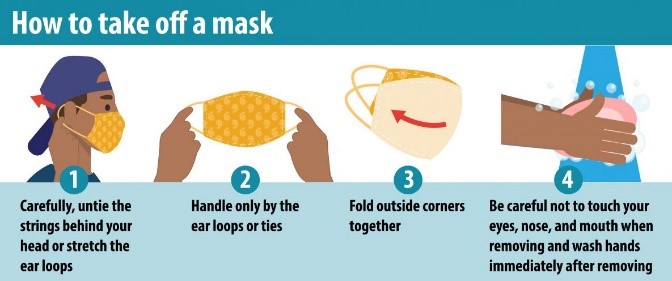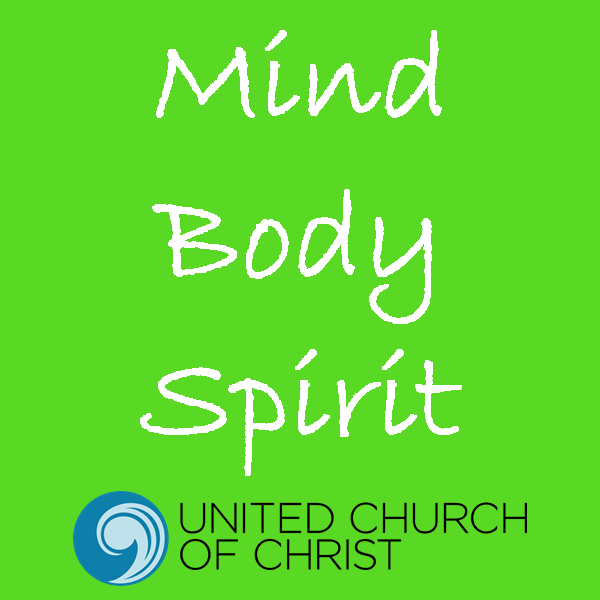Mind Body Spirit – November-December 2020
Mind, Body, Spirit: Linking Lives for Health and Wholeness
The Wellness Ministries of the UCC Newsletter
(formerly The Faith Community Nurse Health Ministry Newsletter)
November-December 2020, Vol. 5 Issue 7
REFLECTION:
“Fight for the things you care about but do it in a way that will lead others to join you”. Ruth Bader Ginsburg

This newsletter is being issued within days of our national election. There’s still time to check the UCC site, Our Faith Our Vote 2020 for election tips and resources. “Your vote is your voice.” As voting results become evident, may every citizen seek opportunities to support community building, promote justice, and offer healing across the country.
HEALTH NOTES:
PREPARING FOR FLU SEASON AMIDST COVID-19 PANDEMIC:
Getting your flu vaccine in September or October was the first step in protecting against a flu infection. Another important step to protect yourself and others is to remain vigilant with safety precautions – the same ones that everyone should be doing to prevent the spread of COVID 19 – wearing a mask, staying a minimum of 6 feet away from others, and repeated handwashing. Along with these steps, disinfecting high-touch surfaces, practicing good cough and sneeze etiquette, and staying home if ill all help to reduce the incidence of these contagious illnesses and other respiratory viruses.
 An interesting note about sneezes: A typical human sneeze exits the body at about 200 miles/hour and emits around 40,000 droplets into the air.
An interesting note about sneezes: A typical human sneeze exits the body at about 200 miles/hour and emits around 40,000 droplets into the air.
The Centers for Disease Control (CDC) has a webpage, with information and guidelines related to this year’s flu season. Another section of the CDC website provides information on the similarities and differences between flu and COVID-19.
A COVID-19 PANDEMIC “REFRESHER COURSE”:
Tips for Mask Wearing:
- Position mask properly. Mask should cover the nose and mouth, form a good seal around them, be secure under the chin, and fit snugly at the sides. Fitting the mask closer to the bridge of the nose may help prevent breath from escaping out of the top of the mask and fogging your glasses. Surgical masks have a bendable band to adjust the mask to the shape of your nose. You can sew a twist tie or pipe cleaner in the top of a handmade mask to do the same thing.
- Make sure your glasses rest on top of the upper edge of your mask.
- You can minimize fogging on your glasses by washing eyeglasses with soap and water and letting them air-dry or using a soft cloth to dry them.
- Remember that masks work by filtering virus-laden particles. Use at least two layers of cloth when making a mask. Higher-count threads with tighter weaves are better than lower thread-count fabrics. Sandwiching cotton batting between the two layers provides good air filtration.
Pointers for Proper Handling of your Face Mask:
- Wash your hands before putting on and taking off your mask (use hand sanitizer if water not available)
- Make sure the mask is snug over nose and mouth. If a mask slips down off the nose, it may be too large, or the ear straps need adjusting. The mask should remain secure while talking.
- Don’t touch your mask while wearing it. If you do touch it, wash or sanitize your hands.
- Remove mask by untying straps or lifting off the ear loops – top loop first – without touching the front of the mask.
 Fold outside corners together (CDC poster).
Fold outside corners together (CDC poster).- Put the used mask in a sealable bag until you can clean it.
- Wash your hands after removing the mask.
- Replace your mask if it becomes wet.
- Carry an extra mask as a replacement, if needed.
- Regularly wash your mask with soap and water by hand or in the washing machine.
- Dry mask completely before wearing it; wet masks may not filter as effectively.
Handwashing:
This is an essential component for preventing the spread of COVID-19. I remember an infectious disease prevention educational program offered at a hospital where I worked as a young nurse. Posters started appearing near sinks in clinical areas with just three words on them, “Ignatz was right.” We all wondered what the words meant, and the infection control educational class gave us the answer: Ignatz was Ignatz Semmelweis, a Hungarian physician who in 1850 introduced handwashing standards after discovering that the occurrence of puerperal fever could be prevented by practicing hand disinfection in obstetrical clinics. He believed that microbes causing infection were readily transferred from patients to patients, medical staff to patients and vice versa. This interesting historical note is a perfect lead-in to the recognition of National Handwashing Awareness Week.
Here are some “handy” tips:
 Remember five easy steps: Wet, lather, scrub, rinse, dry.
Remember five easy steps: Wet, lather, scrub, rinse, dry.- Wash your hands with soap and clean water for at least 20 seconds.
- Be sure to get a good lather going and clean the back of the hands, between the fingers and under the nails.
- Dry them using a clean towel.
- Follow the four principles offered by the American Medical Association and the American Academy of Family Physicians: 1) Wash your hands when they are dirty and before eating; 2) Do not cough into hands; 3) Do not sneeze into hands; and 4) Don’t put your fingers in your eyes, nose or mouth.
THIS MONTH’S WELLNESS MINISTRIES MOMENT . . .
APPROACHES TO FITNESS: MIND, BODY, SPIRIT:
Autumn is a changing season. The natural world is preparing for winter; leaves dry, acorns drop, the air cools, migratory birds take flight, other animals prepare for hibernation. It is an appropriate time for us to reflect on this past year and all it has brought to our daily lives. We have experienced significant anxieties, fears, losses, and grief associated with the pandemic. We have witnessed civil unrest and division, racial tensions, economic challenges, and adjusted to schooling and working from home. UCC Wellness Ministries promote health and wellness within the context of the values, beliefs, and practices of a faith community. Whole person health can be defined as “Integration of an individual’s emotional, intellectual, physical, social, spiritual, and vocational dimensions into positive beliefs and meaningful activities that enhance human functioning and quality of life.” This integration encompasses mind, body, and spirit in its celebration of life, enhancement of coping, and movement toward a sense of wholeness and peace.
MIND: The COVID-19 pandemic has impacted mental health and wellbeing. Stress, anxiety, and depression have increased. There are many resources in response that may be helpful in providing support for yourself and others.
- The Anxiety and Depression Association of America offers helpful resources, videos, and blogs related to COVID-19.
- The Substance Abuse and Mental Health Services Administration (SAMHSA) has a short publication, Coping With Stress During Infectious Disease Outbreaks
- The Centers for Disease Control includes a section Coping with Stress
- The American Foundation for Suicide Prevention offers suggestions for Taking Care of Your Mental Health in the Face of Uncertainty
Sleep impacts brain function. Adequate, restorative sleep can decrease levels of stress. Memory consolidation occurs during sleep as the day’s events are processed, making connections between events, sensory input, feelings, and memories. The association between sleep patterns and mental health relates to both causes and effects.
BODY: November 1st marks Daylight Saving Time. This is a good time to remember to adopt good sleep hygiene habits. Studies continue to show the health benefits of getting 7-8 hours of sleep each night. People who get too little sleep (6 hours or less a night) have higher blood levels of inflammatory proteins (C-reactive protein) than those who get more.
Adequate sleep may help with weight loss. Dieters who are well-rested lost more fat than those who were sleep-deprived who lost more muscle mass. Dieters also felt hungrier when they got less sleep. Sleep and metabolism are controlled in the same area of the brain. When you are sleepy, certain hormone levels go up in your blood and they drive appetite.
Some people have gained weight during their home-staying by increased eating for stress relief, and others have lost weight as a result of increased walking and eating less packaged food or restaurant portions of food.
Some people are now more sedentary and spending more time in front of TV and computers – whether that is for Zoom meetings, entertainment, or following breaking news. Others are turning to activities at home for exercise and body strengthening. Outdoor activities can be safe during the pandemic. Families are using backyards as campsites and many are enjoying walks and visits to local parks while maintaining safe physical distancing.
Increased computer time can cause eye fatigue and computer vision syndrome. The Human eye is primarily for use at far distances, only secondarily for close up work. We are not properly equipped to comfortably spend long periods staring at computer screens. Prolonged computer use causes our ey es to dry out and become sore, our ability to adjust focus slows, and vision may blur. Headaches, sore shoulders, and neck pain may also result. Take “Vision Breaks” BEFORE symptoms develop. Take a vision break of 2-4 minutes length from your computer screen every 20-60 minutes. You can also do this easy eye exercise:
es to dry out and become sore, our ability to adjust focus slows, and vision may blur. Headaches, sore shoulders, and neck pain may also result. Take “Vision Breaks” BEFORE symptoms develop. Take a vision break of 2-4 minutes length from your computer screen every 20-60 minutes. You can also do this easy eye exercise:
- Look away from your computer screen every 30 minutes:
- Focus for 5-10 seconds on an object outside or down the hallway
- Look far away at an object for 5-10 seconds then look at a near object for 5-10 seconds, rocking your focusing back and forth for 10 repetitions
SPIRIT: During challenging times, people need to experience meaningful connections to others. The pandemic has increased both anxiety and loneliness levels for many of all ages. Physical distancing and other approaches to reduce exposure to COVID-19 have resulted in many people experiencing social isolation and loneliness.
Health effects of social isolation and loneliness include high blood pressure, heart disease, obesity, a weakened immune system, anxiety, depression, cognitive decline, Alzheimer’s disease, and even death. National Institute on Aging-supported researchers are studying the differences between social isolation and loneliness, their mechanisms and risk factors, and how to help people affected by these conditions.
Remaining socially connected while physically distancing can enhance spiritual wellbeing. Intentional approaches may help individuals with staying positive during the pandemic. Mindfulness techniques can be another resource.
Religious worship has significantly changed during the pandemic. Virtual worship continues to be the “norm” in many parts of the country. Faith Communities are exploring creative ways for people to remain connected.
Do you have an example of what your faith community is doing to promote connections while maintaining physical distancing? Share your example with us for our next newsletter issue.
HEALTH OBSERVANCES
NOVEMBER:
All Saints Day – November 1st.
In many faith communities, this worship service commemorates those who have died during the past year by reciting their names during the worship service. This year, as these names are being said, we also hold in our silent prayers those whose names we do not know who have died from COVID-19 around the world.
National Survivors of Suicide Day
Saturday, November 21. International Survivors of Suicide Loss Day is an event in which survivors of suicide loss come together to find connection, understanding, and hope through their shared experience. This day is sponsored by the American Foundation for Suicide Prevention which provides suicide statistics and is offering Healing Milestones, a Webinar on November 13th for understanding complicated grief after losing someone to suicide for both suicide bereaved individuals and support group facilitators.
Alzheimer’s Awareness Month
Worldwide, 50 million people are living with Alzheimer’s and other dementias.
The Alzheimer’s Association has COVID-19 resources and support and tips for caregivers in home settings and for individuals in residential care settings.
Family Caregivers Month
There are over 60 million Americans who are unpaid caregivers to family, friends, and neighbors. The Caregiver Action Network (CAN) offers a Family Caregiver Toolkit. One in five caregivers help someone with mental illness. Mental Health America provides a Crisis Planning Worksheet that covers the majority of questions to be considered in preparation for completing legal Psychiatric Advance Directives (PADs). The CDC provides links for Federal, State, and Local resources and how to Get Paid as a Caregiver for a Family Member.
National Hospice and Palliative Care Month
This month is a time to include programs and activities to raise awareness, recognize, and support hospice and palliative care. Family gatherings at Thanksgiving (even if virtual) are a good time to incorporate family discussions on Advance Directives and End-of-Life wishes.
Thanksgiving
Many people will not be able to gather together this Thanksgiving to share meals and blessings. The CDC offers guidelines and tips for Holiday Celebrations. The emotional effects of being separated rather than “gathered together” may contribute additional factors to holiday stress. Tips for having stress-free holidays offer ways to simplify approaches to the season’s holidays. Tips for including children in the virtual activities can add to the enjoyment of family gatherings. Food Safety Tips are an important part of holiday meal preparation.
DECEMBER:
Advent  In addition to the secular activities of this season’s holidays, Advent is a four-week time period to remember and prepare for the birth of Jesus. Advent calendars start on December 1st and count down the days until Christmas. Making an Advent calendar can be a fun activity for parents and children. The Advent Wreath is a symbolic way to pray weekly and participate in this preparatory time. The four candles in the circle represent Hope, Peace, Love, and Joy. A family-constructed Advent Wreath can become a centerpiece that can be included in virtual home worship services.
In addition to the secular activities of this season’s holidays, Advent is a four-week time period to remember and prepare for the birth of Jesus. Advent calendars start on December 1st and count down the days until Christmas. Making an Advent calendar can be a fun activity for parents and children. The Advent Wreath is a symbolic way to pray weekly and participate in this preparatory time. The four candles in the circle represent Hope, Peace, Love, and Joy. A family-constructed Advent Wreath can become a centerpiece that can be included in virtual home worship services.
World AIDS Day
December 1. World AIDS day is an opportunity for people worldwide to unite in the fight against HIV, to show support for people living with HIV, and to commemorate those who have died from an AIDS-related illness. It is a day to recommit to ending the AIDS epidemic. Founded in 1988, World AIDS Day was the first-ever global health day. The theme for 2020 is “Rock the Ribbon”. Activities for schools, colleges and universities, worksites, and communities are also available on the Worlds AIDS Day website. Worship materials are available on the UCAN pages of the UCC.org website.
Human Rights Day
December 10. Human Rights Day is “the day the United Nations General Assembly adopted, in 1948, the Universal Declaration of Human Rights (UDHR): a milestone document proclaiming the inalienable rights which everyone is inherently entitled to as a human being regardless of race, colour, religion, sex, language, political or other opinion, national or social origin, property, birth or other status. Available in more than 500 languages, it is the most translated document in the world.” Eleanor Roosevelt’s words about human rights still resonate today: “Where, after all, do universal human rights begin? In small places, close to home — so close and so small that they cannot be seen on any maps of the world. […] Unless these rights have meaning there, they have little meaning anywhere. Without concerted citizen action to uphold them close to home, we shall look in vain for progress in the larger world.”
Christmas  In the midst of our current circumstances, this year may be a call to hold what is sacred in Christmas. Start a new family tradition that illustrates hope, peace, love, and joy. Share stories, start a family scrapbook of Christmas memories and pictures. Volunteer, donate to meet another’s needs, send cards to those who live alone or are ill. A small book, A Simple Christmas: Celebrating the Old-Fashioned Way in a Post-Modern World by Lori Salkin and Rob Sperry offers 86 ideas for making the season more meaningful.
In the midst of our current circumstances, this year may be a call to hold what is sacred in Christmas. Start a new family tradition that illustrates hope, peace, love, and joy. Share stories, start a family scrapbook of Christmas memories and pictures. Volunteer, donate to meet another’s needs, send cards to those who live alone or are ill. A small book, A Simple Christmas: Celebrating the Old-Fashioned Way in a Post-Modern World by Lori Salkin and Rob Sperry offers 86 ideas for making the season more meaningful.
UCC NEWS:
Toolkits
The Council for Health and Human Services Ministries (CHHSM) has developed a series of toolkits. Volume nine in the series is Mental Health and Substance Abuse. CHHSM also has launched an Anti-Racism Center.
The UCC Overdose and Drug Use Ministries (ODUM) – On October 21st, ODUM hosted a webinar, a Breath of Life: Faithful Responses to Overdose, a workshop and harm reduction worship service, that included overdose prevention, recognition, and response training. Information on how to access naloxone (the medication that reverses an opioid overdose) was made available to all interested participants.
UCC Wellness Ministries: the UCC Wellness Ministries and Faith Community Nurses are currently working on a Wellness Ministries Toolkit. The first segment will be added to their section of the UCC website in the near future.
KEEP CONNECTED:
Visit our FaceBook and Linked-In pages:
Post comments or share information about your health ministries; join in conversations.
Previous issues of the newsletter:
Use previous year’s monthly newsletters to aid your search for links to resources on health ministries and wellness topics:
Contact us:
- Have something you want to share with your colleagues?
- Are you looking for something to assist you in your ministry?
- Interested in joining the Leadership Team for the Wellness Ministries of the UCC?
Let us hear from you.
Contact:
Alyson Breisch, Editor
###


